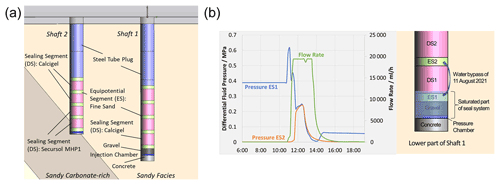Hydration and response of an experimental Sandwich shaft-sealing system at the Mont Terri rock laboratory
A necessary and important component for the closure of deep geological repositories (accessed by a shaft) is a shaft-sealing system that limits the fluid inflow from the adjacent rock to the repository in the early post-closure phase and delays the release of possibly contaminated fluids from the repository at a later stage. The Sandwich system developed at Karlsruhe Institute of Technology (Schuhmann et al., 2009) is a multicomponent barrier that can contribute to this sealing function and is considered as part of the German shaft-sealing concept (Kudla and Herold, 2021). Its functionality has been assessed in a large-scale in situ test (the SW-A experiment) carried out at the Mont Terri rock laboratory (MTRL) in cooperation with international partners as part of the Sandwich-HP project since July 2019. The in situ test was planned as part of an international pre-project (Emmerich et al., 2019) and is accompanied by a laboratory- and semi-technical-scale test program as well as by model simulations.
The setup of the SW-A experiment comprises two shafts of 1.18 m diameter and 10–12.6 m depth in the Sandy Facies of the Opalinus Clay at MTRL. Each shaft contains a Sandwich seal as well as a hydration system in order to realize fluid inflow from the bottom (Fig. 1a). The implemented Sandwich system is characterized by an alternating arrangement of four low-permeability sealing segments (DS) made of bentonite and five equipotential segments (ES) made of fine-grained quartz sand with higher hydraulic conductivity. Fluid entering an ES is supposed to be evenly distributed over the cross section and, thus, the interface of the adjacent DS, leading to a homogeneous hydration and swelling of the DS. Water bypassing a DS and high hydraulic loads can be absorbed and distributed by the next ES. In the experiment, the sealing systems and the surrounding rock are intensely monitored (e.g., geophysics, water content, relative humidity and temperature, pore pressure, stress, and displacement) in order to investigate the saturation process and assess the interaction of the sealing system and the host rock. Hydration of the system in Shaft 1 started in May 2021, and the monitoring system showed a relatively fast saturation of the lowermost ES and DS and a water bypass in August 2021 (Fig. 1b); this was accompanied by slower saturation of the upper ES and DS, swelling of the DS and a pore pressure increase in the surrounding rock. Hydration of Shaft 2 started in May 2023. Data and experience obtained to date will be presented.





